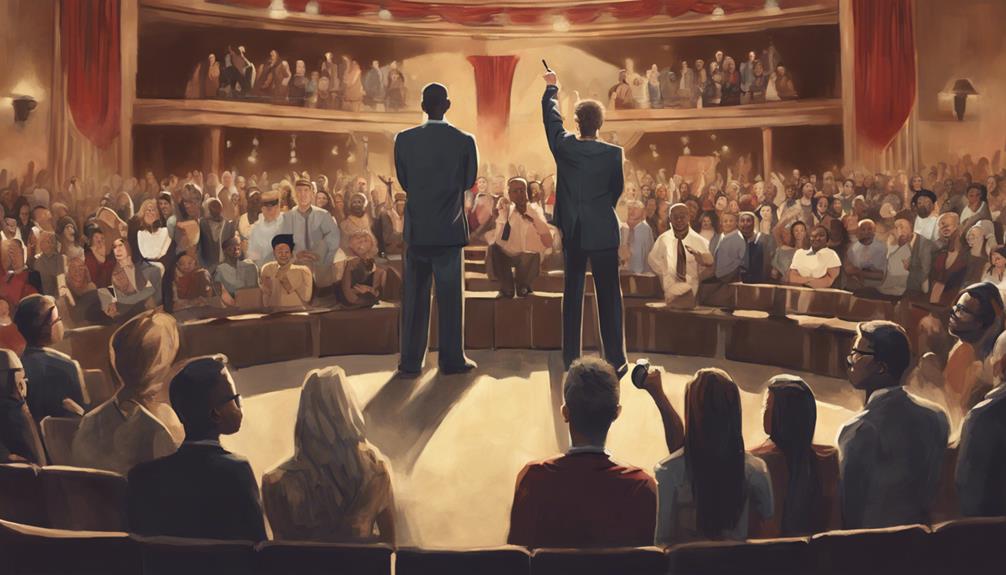Social media's pervasive influence has insidiously eroded the fabric of modern society, cultivating a culture of loneliness, fostering mental health issues, and undermining meaningful human connections. Constantly seeking validation, individuals struggle to cope with the insidious effects of social media on mental health, including increased rates of depression and anxiety. As excessive social media use triggers a cycle of digital addiction, it's important to acknowledge the detrimental effects and take steps to address the growing concern of social isolation perpetuated by social media. By understanding the impact of social media on society, individuals can begin to take control back, reclaim lost time, and improve their mental well-being, and by continuing, they will discover the keys to a healthier online environment.
Key Takeaways
- Social media correlates with increased rates of depression, anxiety, and loneliness, negatively impacting mental health and overall well-being.
- Excessive social media use triggers a cycle of digital addiction, compromising user trust, and perpetuating feelings of isolation and disconnection.
- Real-life connections are essential to mitigate the negative effects of excessive social media use, and fostering genuine relationships is crucial for mental health.
- Setting limits on social media usage and engaging in meaningful activities can help reclaim lost time, improve productivity, and promote mental well-being.
- Acknowledging the detrimental effects of social media on mental health and taking steps to address them can help combat social media addiction and its debilitating consequences.
Social Media's Dark Underbelly Exposed
Behind the façade of social media's seemingly innocuous platforms, a sinister reality lurks, where algorithms and echo chambers converge to wreak havoc on users' mental health and societal cohesion.
Social media sites, once hailed as revolutionary tools for connection and community-building, have morphed into breeding grounds for anxiety, depression, and social unrest. Reports have consistently shown that excessive social media usage correlates with increased rates of depression and anxiety in users.
The algorithms governing these platforms create echo chambers, amplifying dysfunction in society and contributing to the rise in political polarization and institutional distrust. As a result, users face self-censorship and attacks on freedom of speech, limiting shared narratives that bind people.
The consequences are far-reaching, with social media's impact on society including a decline in community engagement and confidence in shared institutions. The dark underbelly of social media is exposed, revealing a toxic environment that erodes mental health and social cohesion.
Mental Health in the Digital Age

As the digital landscape continues to evolve, a growing body of research reveals the insidious effects of social media on mental health, with users of all ages struggling to cope with the fallout. Studies have consistently linked social media use to increased rates of depression and anxiety, highlighting the alarming impact on mental health in the digital age.
The constant need for validation through likes and comments on social media platforms can affect self-esteem and self-worth, leading to a decline in mental wellbeing. Additionally, heavy social media use among young adults has been associated with higher odds of social isolation, exacerbating the negative consequences on social connections.
Social media's hyper-personalization may result in billions of isolated individuals, limiting healthy feedback and critique. By acknowledging the detrimental effects of social media on mental health, individuals can take steps to mitigate these consequences and promote a healthier online environment.
The Lonely World of Social Isolation

How can a platform designed to connect people worldwide end up leaving its users feeling utterly alone? The alarming truth is that social media use is associated with increased feelings of loneliness and isolation, ultimately impacting mental health.
Research reveals a disturbing trend among young adults, where heavy social media usage is linked to a rise in social isolation. Hyper-personalization on social media platforms may lead to billions of isolated individuals, disconnected from real-life interactions. Excessive online sorting can disconnect individuals rather than connect them, exacerbating the issue.
Furthermore, social media limits healthy feedback and critique, contributing to a sense of social isolation. Young adults, in particular, are susceptible to these effects, as they're more likely to engage in excessive social media use. The consequences are far-reaching, with social isolation linked to a range of mental health issues, including depression and anxiety.
It's essential to acknowledge the role social media plays in perpetuating social isolation and take steps to address this growing concern.
Screen Time: The Silent Killer

As people spend more time glued to their screens, the risks of digital addiction become increasingly apparent.
Screen time has been linked to a multitude of mental health issues, including depression, anxiety, and decreased self-esteem.
As the silent killer of modern society, excessive screen time poses a significant threat to individuals' overall well-being.
Digital Addiction Risks
Excessive social media use triggers a vicious cycle of digital addiction, quietly corroding mental and social well-being. As individuals become increasingly dependent on social media for social acceptance, they unknowingly sacrifice their mental health. The constant stream of curated content fosters unrealistic comparisons, further exacerbating feelings of inadequacy.
Additionally, data scandals have compromised user trust, yet the allure of social media remains strong. Heavy users are more susceptible to social isolation, as they substitute online connections for meaningful, in-person relationships. This hyper-personalization on social media may lead to billions of isolated individuals, rather than fostering a sense of community.
Mental Health Impacts
Screen time silently corrodes mental health, fostering an epidemic of loneliness and disconnection among young adults.
The alarming truth is that heavy social media use is linked to higher odds of social isolation in young adults. This is largely due to the media's influence, which perpetuates a culture of hyper-personalization, contributing to billions of isolated individuals.
Furthermore, social media limits healthy feedback and critique, affecting mental health. Excessive online sorting disconnects rather than connects individuals, shrinking their worlds to content generating immediate engagement.
Young people, in particular, are vulnerable to these negative effects, as they spend a significant amount of time online. The consequences are far-reaching, with mental health impacts ranging from anxiety and depression to increased feelings of loneliness and disconnection.
It's essential to recognize the mental health impacts of screen time and take proactive steps to mitigate these effects. By doing so, we can promote healthier online interactions and foster a more connected society.
Real-Life Connections in Peril

One in four people admit to preferring online interactions over in-person connections, highlighting the alarming erosion of real-life social bonds. This shift towards digital communication is having devastating effects on our mental and emotional well-being. Social media's impact on real-life connections is particularly concerning, as it contributes to feelings of loneliness and isolation.
| Online Interactions | Real-Life Connections |
|---|---|
| 24/7 availability | Limited by time and space |
| Lack of nonverbal cues | Rich in nonverbal cues |
| Often superficial | Deeper, more meaningful |
| Can be edited or deleted | Unfiltered, genuine interactions |
The decline of face-to-face interactions and communication skills is a direct result of our reliance on social media platforms. This comparison culture on social media is causing low self-esteem, body image issues, and fostering jealousy among users. It is essential to recognize the importance of nurturing real-life connections to mitigate the negative effects of excessive social media use.
Breaking Free From Social Media Addiction

Breaking free from social media addiction requires recognizing the warning signs and taking deliberate steps to regain control over daily habits and relationships. The rapid evolution of social media has led to a significant impact on mental health, with excessive use linked to increased feelings of loneliness and depression. On average, individuals spend around 2 hours and 24 minutes on social media platforms daily, leading to decreased productivity and disrupted sleep patterns. Additionally, over 50% of young adults report feeling anxious or depressed after using social media. Recognizing these warning signs is essential in breaking free from addiction.
Taking Back Control of Our Lives

As individuals recognize the detrimental effects of social media on their well-being, they're taking steps to break free from addiction and regain control of their lives.
By acknowledging the time wasted on social media, people can redirect their energy towards more fulfilling activities, leading to a more balanced and healthy lifestyle.
Break Free From Addiction
By recognizing the vicious cycle of social media addiction and its debilitating effects, individuals can take the first essential step towards reclaiming control over their lives. Digital platforms reveal how social media addiction is leading to increased feelings of loneliness, anxiety, and depression among young adults.
The constant need for validation and comparison with others on social media is causing low self-esteem, body image issues, and a constant need for validation. Cyberbullying, FOMO (Fear of Missing Out), and exposure to triggering content are contributing to declining mental well-being and self-worth.
Distractions from work, decreased productivity, and disrupted sleep patterns are common consequences of social media addiction. To break free from addiction, individuals must acknowledge the negative impacts of social media on their lives. By doing so, they can begin to detach themselves from the digital world and focus on rebuilding their self-worth, relationships, and overall well-being.
Regain Lost Time
With the average person sacrificing a substantial 2.5 hours daily to social media, reclaiming this lost time is essential for regaining control over their lives. This excessive screen time not only leads to decreased productivity and increased procrastination but also negatively impacts mental health and overall well-being.
To take back control, individuals must set limits on their social media usage and allocate that time to more meaningful activities.
By doing so, people can:
- Engage in physical activities that bring people together, such as group fitness classes or team sports, and encourage others to exercise alongside them.
- Pursue hobbies and creative interests that foster a sense of accomplishment and fulfillment.
- Focus on building meaningful relationships by spending quality time with family and friends.
- Dedicate time to personal growth and self-improvement, leading to increased confidence and self-awareness.
Frequently Asked Questions
How Is Social Media Destroying Society?
She believes social media is destroying society by fueling depression and anxiety, polarizing politics, and eroding community engagement, ultimately amplifying dysfunction and undermining trust in institutions, contrary to its original intentions.
How Is Social Media Harmful to Society?
She notes that social media harms society by fostering depression and anxiety, political polarization, and institutional distrust, while decreasing community engagement and confidence in shared institutions.
How Is Social Media Killing Us?
She emphasizes that social media is killing us by fueling depression, anxiety, and political polarization, while eroding community engagement, and argues that it's essential to reassess our online habits to mitigate these devastating effects.
How Can We Avoid the Negative Impact of Social Media?
One in five young adults experience social isolation due to heavy social media use. To avoid its negative impact, she sets boundaries, engages in offline activities, and cultivates meaningful relationships by being authentic and empathetic online.
What Can I Do to Counter the Negative Effects of Social Media on Society?
In response to the alarming truth about social media, individuals can counter its negative effects by limiting screen time and practicing digital detox. Engaging in meaningful face-to-face interactions, promoting positive content, and educating about digital literacy are also effective ways to mitigate the impact of social media on society.
Conclusion
As the curtain closes on the dark underbelly of social media, the truth remains: our mental and emotional well-being hangs in the balance.
With each scroll, like, and share, we edge closer to a precipice of loneliness, anxiety, and addiction.
Yet, there's hope. By acknowledging the perils and taking back control, we can break free from the shackles of social media addiction and reclaim our lives.
The question remains: will we take the first step towards a healthier, more authentic existence, or will we succumb to the void of endless scrolling?










